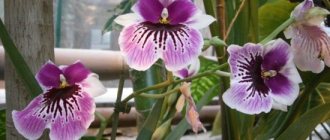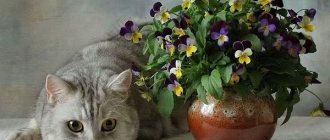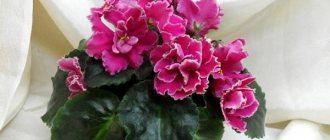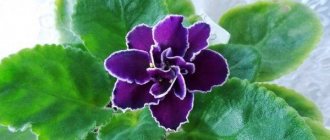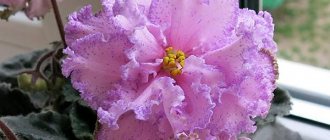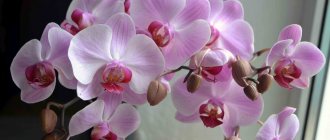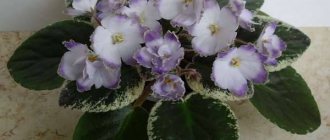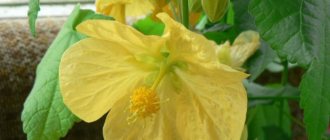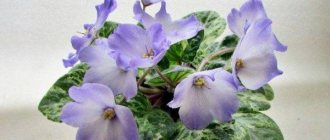Flowers that look like violets
The most famous and popular perennial flowers similar to house violets are:
- Achimenes;
- deikun;
- gloxinia;
- Streptocarpus.
Achimenes
If you see that a flower in a pot looks like a violet, then most likely it is Achimenes. The flowering plant resembles a violet with flowers consisting of five petals.
Achimenes.
A striking similarity is noted in the early period of development of the culture , when the plant has not yet become very elongated and sits in a pot as a strong bush. In adulthood, the culture is ampelous. Achimenes petals can be of different colors. Including:
- purple;
- bluish;
- pink;
- light lilac;
- whitish-purple;
- scarlet, etc.
People who grow violets will find it easy to grow achimenes. Decorative culture requires the same care as violets.
Achimenez will feel great in a bright room, but where there is no direct sunlight. It needs high air humidity. To do this, the flower is often placed in the kitchen area.
It should be watered carefully and no more than three times a week. Warm, settled water is suitable for the procedure. The watering can is not directed at the greens; only the root zone is watered.
Stagnation of water should not be allowed. This will cause rotting of the root system. The pot should have plenty of drainage.
Important! Achimenes does not grow in the winter season. In winter, its aerial part dies off, and the pineal rhizome rests.
Deikun
The more famous name of the flower is Cinderella's Dream . The ruffled semi-double edges of the neat petals are reminiscent of a ball gown. This flower is a representative of a new selection of violets. The edges of the petals, which have a terry-net structure, stand out in color from the main petal.
Usually the petal is snow-white in color, and the corrugated edges are covered with a lilac, pink, purple or lilac border. The leaves are moderately velvety, curved-wavy in shape. The upper part of the leaf blade is emerald, the lower part is brick or reddish-green.
Violet Cinderella's dream (Deikun).
Deikun does not tolerate cold, heat, direct sunlight, darkness, or drafts. It is best to keep it in a lighted, ventilated room, where it is about +19…+23 degrees. The soil substrate must be loose. The soil should be moistened every 2 days.
Gloxinia
A violet that looks like a bell is gloxinia, an ornamental crop that resembles a violet with its leaf blades. They are round, slightly elongated, strong. Light velvety pubescence and light veins are noticeable. Leaf color is green.
Gloxinia (close-up photo of the flower).
The leaves do not form rosettes like those of a violet, but grow tightly to each other. The color range of gloxinia is extensive . The prevailing petal colors are:
- lilac-lilac;
- scarlet;
- pink;
- snow-white, etc.
The plant prefers to be in a bright place with diffused bright lighting. The air should not be dry. Otherwise, the stem and leaves with flowers will wither.
Like violets, gloxinia should not be sprayed with water from a spray bottle. To humidify the air, it is recommended to place a container of water in the room. Due to the inadmissibility of drops getting on the green mass, gloxinia should be watered at the root or pour water into a pan.
Gloxinia needs hibernation every year. The dormant period begins in the fall. At this time, the bush is pruned, and the pot is placed in the basement or underground, where it is dark and cool.
Tubers need moisture even in winter. They should be watered once every 20-35 days.
Advice! The culture is responsive to feeding. It is recommended to apply mineral fertilizers to the soil every 50 days, which contain no nitrogen or very little of it.
Streptocarpus
A bright decorative specimen that attracts attention with its fancy miniature neat flowers. The color can be very different - from blue, dark burgundy to snow-white and pinkish.
Streptocarpus.
This indoor plant blooms in the summer . For good growth, a lighted place is necessary. It would be ideal to place it on a windowsill facing east.
The plant is resistant to short-term drought and quickly recovers after watering. It is best to water it every 2-3 days through a tray. In winter it goes to rest.
Techniques for propagating indoor violets
Provides care for home violets using competent methods of propagation. The preferred method for maintaining varietal purity is cuttings. A healthy leaf with a petiole is selected as a cutting. It is not recommended to take old, coarsened leaf plates of the lower row, as well as yellowed or damaged specimens.
It is advisable to select a leaf located in the second row with a strong, elongated petiole. Preference is given to a lighter color of the leaf plate if a different color shade is observed. Among pinnate violets, the selection criterion is the predominance of green color, which makes up more than half of the surface.
When propagating homemade violet flowers, it is advisable to break off the leaf at the base so as not to leave a stump. If you had to use a knife, then the cut area is cleaned, removing the remaining part. This measure allows you to save the plant from rotting. For transportation, the cutting is placed in a dampened textile napkin and placed in a bag.
There are two methods for rooting cuttings.
The traditional and well-known method of placing a cut leaf in water has a significant advantage, since it allows you to control the ongoing processes, making the necessary adjustments in a timely manner. The optimal petiole length is approximately four centimeters. This indicator will allow it to be trimmed in case of possible rotting.
The container can be from the category of ordinary plastic glasses with a volume of 100 ml. It is filled with cool, pre-boiled water. The lower edge of the cutting is cut at an angle, increasing the cross-sectional area, and placed in a vessel. To prevent curvature, a circle of cardboard with a hole in the center is placed on top, into which the petiole is inserted. It should not touch the inner surfaces of the glass.
Place the prepared tank in a warm place with sufficient lighting, protected from drafts. For further planting in the ground, the length of the roots should reach approximately one centimeter.
The second method simplifies the propagation process, since the cutting is immediately placed in a soil mixture consisting of turf soil and peat in equal parts. If a plastic glass with a capacity of 150 ml is taken as a micro nursery, then small holes should be made at the bottom, then drainage should be poured - small stones, expanded clay, pieces of polystyrene foam and prepared soil. Having made a depression of up to two centimeters, place the stalk with a slight slope and sprinkle it, lightly compacting it, trying not to break the delicate petiole. The top of the glass is covered with a glass or plastic transparent jar.
Almost the same manipulations will have to be done with the cuttings, which have taken root in the water. Babies begin to appear after a month and a half or later. After they reach a size of three centimeters, you can plant young homemade violet flowers in separate containers. It should be remembered that variegated young seedlings must have time to cover more than one third of the leaf plate with green. If there are white leaves, the mother leaf is not removed.
Violet flower care at home. Video
Street flowers that look like violets
Violet-like flowers are often planted as decorative decorations in flower beds and garden paths. Almost all varieties of “street violets” are perennial plants. These colors include:
- primrose;
- petunia.
Primrose, or primrose, belongs to the primrose family; the appearance of the flower resembles a violet.
. Primrose is perennial; flowering begins after the snow has completely melted. Blooms until the end of May. More than 500 species of primrose are known in nature. It looks like a small bush (no more than 30 cm in height). Leaves with pronounced veins, green or dark green. The flowers are usually collected in umbellate or spherical inflorescences, and solitary ones are also found. Petals of various colors: yellow, red, blue, lilac, sometimes two-color, with a clearly defined center.
Petunia is a garden herbaceous bush with a taproot system. The stems are branched, thin, green in color. They can be short or tall. Petunia leaves are small in size, green or dark green in color, alternate, covered with fine fluff. The inflorescences are single, of various colors, monochromatic or two-colored.
Dog violet
In May, on forest edges, in thickets of bushes, under the canopy of sparse forests, and even in open places - meadows, fields, along the banks of reservoirs - the dog violet (Viola canina) blooms.
Dog violet in a sparse forest
Why they called her that - I don’t know, sorry! It is clear that this is a literal translation into Russian of the Latin name. The plant is not too noticeable, but interesting. The flower, like other violets, is five-membered. But the petals are already one color, mostly pale blue. There may be several of them on one stem, on long peduncles. The leaves of the dog violet are stem, alternate, on cuttings. Basal leaves appear only after flowering.
Like many spring-blooming plants, dog violet is a myrmecophilous plant. Indeed, ants (“myrmekos” in Greek) take the most active part in the distribution of its seeds. In June, fruit boxes already ripen in place of the flowers. The ripe fruit cracks, its leaves curl, scattering the seeds. But each seed is also equipped with a special body to attract ants, like lungwort, liverwort or corydalis. Ants take away the seeds, and they can spread quite far.
But I still can’t pinpoint this violet!
Swamp violet?
Quite large leaves in a basal rosette, heart-shaped at the base. Single pale blue flower. Grows in spruce-birch forest on fairly moist soils. I looked through several determinants, but I’m not completely sure...
For an accurate identification, for that matter, the plant had to be picked or dug up in order to carefully study its structure. I just took a photo and can tell from the photo.
Most likely, this is the marsh violet (Viola palustris).
Violet tricolor pansy
The most famous of our violets is, of course, the tricolor violet (Viola tricolor), or pansy. It cannot be called a typical forest plant, because it is found both in arable land and in the garden. But you can also see this flower in thickets of bushes and on the forest edge. The plant is annual or biennial. The tricolor violet is so named because its flower is the most variegated of all violets.
Violet tricolor, or pansy
I probably won’t describe the flower in great detail. Because there are few people who are not familiar with him. A peculiar corolla of five free, differently colored petals. Typically the top two petals are purple, the middle ones are blue, and the bottom one is yellowish. Shades, however, may vary.
Beautiful flower! Of course, all this beauty was not created for us, but for the sake of attracting pollinating insects. The lower petal contains a blunt spur with nectar, and is also a landing site for such guests. Violet veins are clearly visible on it, indicating the path to nectar for insects.
The tricolor violet begins to bloom in May, and blooms all summer. Already in June its fruits - boxes - begin to ripen. They open with three doors, scattering seeds throughout the surrounding area.
For their beauty and expressiveness, pansies have long been a cultivated plant. More precisely, garden pansies, many varieties of which delight us in flower beds, are, of course, not exactly our tricolor violet, but the result of hybridization of several species: tricolor, yellow and Altai violets.
Pansies are also known as a good medicinal plant! After all, they contain a whole range of useful substances: flavonoids (including rutin), essential oil, saponins, carotene, ascorbic acid, vitamins P and E. Tricolor violet collections are used to treat colds. This is a good expectorant, thinning mucus in the bronchi and facilitating its release. Pansy herb also has antipyretic, diaphoretic and diuretic effects. For medicinal purposes, at the beginning of flowering, the entire above-ground part of the plant is cut off and dried in the usual way - scattered under a canopy in the shade.
Even in the mythology of different nations there is a modest flower. Among the ancient Greeks, it is associated with the names of not just anyone, but the most important gods - Aphrodite and Zeus himself!
The plot of one of the myths is as follows. One day, Aphrodite, the goddess of love and beauty (a rather bitchy person, between you and me!) was bathing in a remote grotto. And suddenly she noticed that they were spying on her... And not just anyone, but several mere mortals
What will a bathing woman do if she notices the inappropriate attention of curious people? (Swimsuits haven’t been invented yet!) That’s right, he’ll be angry. So Aphrodite, in anger, demanded that Zeus punish the culprits with death! And he completely obeyed, but still took pity on the culprits and turned them into flowers reminiscent of their curious eyes
According to another myth, pansies were created by Zeus in order to console the poor beauty Io. To hide his love affairs from his jealous wife Hera, he... turned Io into a very beautiful white cow. And as a consolation... he gave her beautiful flowers as food. Comforted, so to speak!
Unfortunately, I don’t know anything about pansies from Slavic mythology. But it certainly happened!
In addition to pansies, we also have other beautiful violets.
Primrose
A perennial flower similar to a violet that begins to bloom immediately after the snow melts. The flowering process in good weather conditions lasts until the end of May. And although the plant resembles a violet, it is a small bush up to 30 cm in height, and the flowers are single and resemble the shape of an umbrella.
Color variety: blue, pink, lilac. Primrose also has more than 500 different species.
Reference. Primrose can be planted in any climatic conditions; it takes root well in any soil. It does not require abundant watering; it can additionally be fertilized with mineral supplements.
Petunia
And although petunia looks like a violet with its flowers, it is a large, growing bush. Its leaves are small in size, and the bush itself can be tall or short. The flowers are solitary and can come in more than 20 different colors. At the same time, they can be monochromatic or combine 2 or more colors.
Reference. Gardeners warn: to grow petunia, the soil must be neutral and loose, and sand can be used when sowing.
Achimenes
Indoor flowers called Achimenes can bloom 2-3 times a year. The buds bloom quickly and delight with long-lasting flowering. The plant, which resembles a violet with its flowers, is very unpretentious in maintenance, but needs sufficiently humidified air. And flowers react to temperature changes.
This plant is popular because anyone can grow it at home. Achimenes dot and blueberry ripple are considered the most similar to violets. The color variety is very wide, bright colors, with a beautiful transition from light to darker shades.
Centopoly
Centopoly or indoor violet. The fringed centopoly has gained popularity among gardeners. It is sometimes called curly. The edge of the violet is white at the right temperature. And the colors of the plant are very diverse: from light pink to dark purple. The color is also affected by the quality of the soil.
You can use mineral fertilizers, which also affect the color of the plant. Centopoly needs good lighting and does not tolerate temperature changes.
Indoor flowers - “doubles”
Among the pets, the violet has “doubles”. The most popular are:
- gloxinia;
- streptocarpus;
- deikun.
Gloxinia is often confused with indoor violet.
. Does not require special conditions of detention. A perennial herbaceous bush with a short stem (5 to 20 cm). The leaves are dense with pronounced veins. The inflorescences are double, of various colors, with clear splashes of white and burgundy color.
Streptocarpus is a perennial herbaceous plant that resembles a violet. It can be annual or perennial. It is considered a close relative of Saintpaulia.
The leaves of Streptocarpus are wrinkled, green in color, with pronounced veins. The inflorescences are simple, double, petals of various colors: pink, white, blue, red, purple.
Deikun, or Cinderella's dream, belongs to the genus of hybrid Saintpaulias. It has dark shiny leaves with a purple back. The flowers are creamy-white, double, collected in a rosette. The petals are most often two-colored, edged with fringe. Flowering is frequent and abundant.
Description and types of flower
Modern hybrid gloxinia is a plant with a short stem that grows from a rhizome-tuber. The leaves are wide, velvety, with a wavy edge. The main decoration of gloxinia is bell-shaped flowers with bent petals. They come smooth or with a frill. The height of the peduncle ranges from 10 to 25 cm, and the diameter of the flower reaches 8 cm.
The colors of the petals are varied: red, purple, white and their combinations. Often there is a variegated color with spots of different sizes, a border along the edge. The petals can be arranged in two rows, forming something like a double flower. But more often they are simple. Gloxinia blooms for about 2 months. The buds do not open simultaneously, replacing each other.
- Brocade is a dwarf variety with small leaves and beautiful double flowers.
- Avanti with small dense leaves and large monochromatic flowers of different colors.
- Kaiser is up to 30 cm high and has large flowers with a white border around the edge. Kaiser Frederick blooms with red flowers, Kaiser Wilhelm with dark purple flowers.
- Hollywood features large, velvety flowers in varying shades of purple. They decorate the bush in May and June.
Gloxinia is sometimes confused with Usambara violet (Saintpaulia). They look like leaves covered with small dense fibers. The colorful flowers with delicate petals are also a bit similar. But in fact, these are different plants, although they belong to the Gesneriev family. The violet does not have a tuber. Its leaves are more durable and rounded, and the flower does not have the shape of a gramophone.
Gloxinia settled in European homes in the 18th century, and Saintpaulia a century later, in the 19th century. At the same time, violets are more common and known among us. Everyone knows them, but many have never even seen gloxinia. This may be due to the fact that it is more difficult to care for. Often it does not come out of the dormant period due to improper care, while the violet remains green all year round.
Turkish clove
Gardeners love Turkish cloves for their brightness and unpretentiousness. There are low-growing plants that resemble violets, as they reach a height of 15-20 cm. And there are tall plants, more than 80 cm in height. Turkish carnation can also be planted in the garden. The big disadvantage of these flowers is that they are highly susceptible to pests.
The bright, variegated colors of the plant always attract attention.
This plant requires careful care, namely:
- weed removal;
- frequent loosening of the soil;
- frequent watering;
- fertilizer;
- protection from pests.
Gloxinia
Flowers in pots, whose name is Gloxinia, are considered very sophisticated and special. And although they have similarities with violets, the stem of gloxinia is much thicker and stronger. The flowers reach a diameter of up to 7 cm, and the plant itself requires a lot of space and light.
There are several conditions under which the plant will take root and bloom for a long time:
- Fertilizing with nitrogen-free fertilizers.
- Large pot size.
- To ensure flowering lasts all year round, you need to build an insulated rack and additional lighting.
Methods for getting rid of pests and diseases
The fight against the negative consequences of diseases must be included in flower care at home. If the violet is exposed to excessive soil moisture, rot may develop at the base of the stem, which weakens the plant. It should be replanted in a new soil mixture and the watering regime adjusted.
Light yellow stains and spots on the crown can cause the proliferation of sucking pests - greenhouse thrips. Adult insects reach a narrow body length of up to 1.5 mm and are brown in color. The larvae have a yellowish tint. To get rid of it, dust the plant with pyrethrum.
If jumping small springtail insects (springtails) colonize indoor flowers, the violet may die due to rotting of the roots, as evidenced by these insects. When there are few insects, they provide benefits by eating rotting tissue. Large populations begin to harm when they reach healthy roots. The soil is treated with pyrethrum, crushed shag or crushed citrus peels.
Saintpaulia diseases
If violet maintenance conditions are violated, plant diseases are very likely. If the leaves begin to turn yellow or brown spots or even holes appear on them, this means that the leaves are exposed to direct sunlight. The pot should be removed to a less lit place or shaded. Another reason for yellowing leaves may be too dry air. The plant must be placed on a tray with water.
When the soil is waterlogged and there are sharp temperature fluctuations, indoor violets are affected by root rot. In this case, it is better to throw away the plant, sterilize the pot and soil or replace it.
If the violet is sprayed or watered heavily, gray mold may appear on the leaves. These are fungal diseases - gray rot or powdery mildew. The simplest solution to the problem is to remove the affected leaves, stop spraying the flower, and move the pot to a warmer and well-ventilated place. You can treat the plant with ground sulfur or a special fungicide. The treatment must be repeated after a week.
Of the pests, Saintpaulias are affected by the whitefly - this is a very small flying insect. Its larvae settle on the underside of the leaf. They are destroyed by preparations containing pyrethrum. The affected plant should be sprayed every three days. Another pest is the mealybug. A small white insect covered with fluff. It is most easily removed by wiping the leaves with a damp swab. Another way is to treat the leaves with insecticides.
Growing and caring for Uzambara exotica
When the right conditions are created, a representative of the Gesneriaceae family is able to bloom all year round. To create comfortable conditions, you need to choose the right soil, know how to water, prune and propagate the plant, what and when to fertilize the plant with, and how to replant the flower if necessary.
It is necessary to choose the right pot: it must be at least 13 cm deep. When growing African exotic at home, you must adhere to the optimal temperature - +22...+24 °C. The pet does not tolerate drafts; it must be protected from direct sunlight and sudden changes in temperature. The plant prefers to grow in loose and light soil; the substrate should absorb moisture well and allow oxygen to pass through. Specialized substrate can be purchased in specialized stores. Recommended soil composition:
- peat;
- leaf soil;
- coniferous soil;
- turf soil;
- river sand.
Saintpaulia is capricious in terms of watering. Experienced flower growers recommend choosing a middle ground; the soil should not be allowed to become waterlogged or dry out. Watering the plant must be done with settled, warm tap water. To maintain the necessary humidity in the air, experts recommend spraying moisture around the flower.
It is recommended to avoid getting water on leaves and flowers; the plant may get burned.
For full flower growth, additional lighting must be installed. Artificial light sources should illuminate the plant for about 13 hours a day.
You will have to fertilize your homemade Uzambara violet regularly, especially if the plant looks healthy but does not bloom. Feeding is carried out once every 14 days, with a special complex of vitamins and minerals. The necessary fertilizer can be purchased at a specialized store.
Care during the flowering period
The variety of ways to propagate dracaena
Caring for gloxinia during the growing season is almost the same as caring for Uzambara violet:
Gloxinia is installed in a warm, bright place, protected from drafts. Lighting should be diffused. Avoid direct sunlight on leaves and flowers. They cause burns and even death of the plant. If the length of daylight is less than 14 hours, gloxinia leaves stretch vertically; if there is enough daylight, they are arranged horizontally. The soil in the pot with gloxinia should not dry out. You can’t overwater it either, so that the roots don’t rot.
Water the flower carefully, avoiding getting it on the leaves and flowers. Drops of water cause stains on them
Take soft, settled water; its temperature should be slightly above room temperature. 15 minutes after watering, excess water is drained from the pan. To successfully grow gloxinia, moist air is needed. If it is dry, the leaves turn yellow and the buds fall off. But you can’t spray the flower because of the large number of small fibers on the leaves and stem. Therefore, they spray water near the plants or place trays with water nearby. You can place a pot on them, but its bottom should not be in water. In this case, the roots will rot and the gloxinia will disappear. In order for the flowers to be large and bright, gloxinias need to be fed. A special mineral fertilizer has been developed for them, which can be bought at a flower shop. You can use regular fertilizer for flowering plants, but apply it at half the recommended dose.
Gloxinia can be induced to bloom again. To do this, after flowering, it is cut off, leaving two leaves. Water and care as before. Shoots will soon appear from the axils of the leaves, on which buds will subsequently form. Flowering will not be as lush as the first time.
Streptocarpus
A plant that reaches a height of 30 cm and can be grown at home in a pot. The flowers and leaves are slightly hairy and the flowers are umbrella-shaped.
The plant has many advantages:
- Easy to care for.
- Lush and long flowering (more than six months).
- If the plant does not bloom, it can be planted outside.
- Ease of reproduction.
We offer you to read a complete review of Streptocarpus indoor flowers.
Lyubka bifolia
A plant that looks more like an orchid than a violet. The plant is not grown at home, and it does not always take root in the ground. It grows more in forest areas with high humidity, but requires good lighting.
If you grow this plant in the garden, it needs frequent watering and additional fertilizer. This plant is not very popular among gardeners due to its whimsicality and difficulty of care.
